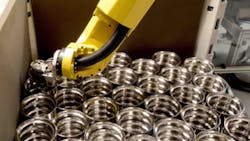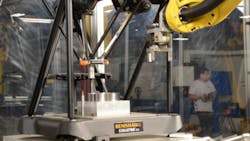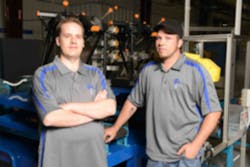Fully Automated Machining … and Tending, Inspecting, and Packaging
Conroe Machine in Conroe, Texas, is doing what most machine shops only dream of doing – hard turning a family of parts around the clock in an unmanned cell that operates a "self controlled" process. The shop is proving that unmanned machining is not an impossible dream; it’s achievable for any shop ready to trust its automation objectives to talented, though young experts, and to exploit new technology like Renishaw's programmable Equator™ gauge.
The turning cell, with software and programming developed by CNC programmer James Wardell and robotics technician Jeff Buck, integrates a Fanuc robot with the Equator gauging system using Renishaw EZ-IO software to provide comprehensive communication for 100-percent part inspection and auto-compensation of a twin-spindle Okuma 2SP-250 lathe. The cell also boxes and palletizes finished parts.According to Conroe Machine sources, the cell paid for itself in a remarkably short period of just 18 days.
The same automation team later developed an unmanned cell for part measurement/sorting. for a customer, this time combining two Equators, a Fanuc robot, a vision system, and multiple lanes of low-profile conveyor. In each application, the Equator demonstrates the value of programmable comparative inspection by quickly measuring a family of bearing races, doing it cost effectively -- and without fixturing or other complications for a shop floor environment.
As a manufacturer, Conroe Machine is a relatively young too, founded in 2000 by Murray "Tippy" Touchette, with the expressed objective to produce parts with the best manufacturing technology available. The company has grown to about 150 employees and operates now in a climate-controlled 65,000-square-foot plant. While it is a general-purpose shop, Conroe’s location near Houston means that a high volume of business comes from customers operating in the oil-and-gas industry, principally involving drilling components. One of the jobs running continuously at the shop is manufacturing of thrust bearing races for downhole mud motors. These parts are produced by the thousands every week, around the clock.
Moving Up the Automation Ladder
The bearings are roughed-out on four Doosan Puma lathes that originally performed both roughing and finishing, tended by four operators. Now, these machines are rearranged into two cells, loaded and unloaded by Fanuc robots, and handling only the roughing operation. These cells were among the shop’s earlier automation projects (see Conroe's Johnny 5 robot in action.)The semi-finished parts produced there are sent out to be case hardened to HRC 65 at a depth of 0.070 in. (1.7 mm) before the finish turning.
“Our production plateaued at 800 to 1,000 total parts per day with these two cells,” James Wardell explained. “We had a single operator loading the machines and inspecting the parts. However, you can rely on an operator to correctly inspect only so many parts with this kind of volume, and we needed even more output.
“For our next step up, we conceived a fully automated process for the finish machining, with automatic part loading, post-process measurement, automatic tool compensation, part engraving, and boxing/palletizing the parts,” he detailed.
“We had pretty good ideas for the components of such a system, except for the part measurement technology, CNC type, and software for tool compensation. Inspection must be fast to keep up with the cycle times on the parts, which can be as short as 98 seconds. Originally, we looked at white-light laser inspection because of its speed, but the parts are too reflective.
“We also looked at hard gauging and shop-floor CMMs,” Wardell continued. “Hard gauging was very expensive and required setup attention, and the CMM gave no speed advantage. While working with Renishaw on other projects, we were introduced to the Equator as a possible solution.”
The Equator is a low-cost, flexible alternative to dedicated gauging. It uses the comparison method of measuring. A master part with known measurements taken on a CMM is used to "master" the Equator, with all subsequent measurements compared to the master.
Repeatability is 0.00007 in. (0.002 mm) immediately after mastering. To compensate for shop temperature changes, the Equator can be re-mastered at any time. The Equator uses an SP25 probe for touch and scanning data collection, at speeds of up to 1,000 points per second. Styli are stored in an integral six-port changing rack, and the system is programmed through MODUS™ Equator software. The Equator can be used manually with push-button ease, but its EZ-IO software for automation also makes it ideal for integrating into cells like Conroe's.
“We attended an open house at Hartwig in early 2012 and saw the Equator in action, along with Okuma’s twin-spindle dual-gantry lathe,” Wardell recalled. “Apart from being automation-ready for parts of our type, the lathe’s Windows®-based OSP dual-path control has an open-architecture, PC-based operating platform, which was important in our plan for developing our own auto-compensation software.”
Gauging as Part of the Automated Cell
Wardell and Buck proceeded to install a cell consisting of the Okuma 2SP-250H, a single Equator, an engraving machine, and a Fanuc M20iA 6-axis robot. In practice, the lathe’s two part carousels are loaded with raw workpieces, approximately 300 parts. The lathe’s dual gantry loaders feed the spindles and place finished parts on a chute leading to a conveyor for pickup by the robot.
The robot places the part on the Equator for measurement and, if acceptable, it transfers the part to the engraving machine, and then finally boxes/palletizes the finished pieces.
“We developed our own tool compensation software to run on the OSP control,” Wardell added. “This software uses measuring results from the Equator, transmitted in the form of a CSV file, to offset the tools when the part deviates from tolerance.” Machining removes about 0.015 in. (0.38 mm) from each side of the part, with the tightest tolerance at ±0.001 in. (0.025 mm) and an 8-microinch (0.5-micron) surface finish. Parts range in size from about three to six inches OD. “The Equator is easily able to measure within our tolerances, with a high margin,” Wardell said.
“Our OD/ID stays spot-on, with perhaps a couple of tenths variation on radius,” he emphasized. “We batch-process parts by size, so changeovers of chuck jaws and other tooling are minimized. The Equator’s speed allows it to keep pace with the process easily. We re-master only once a day, because our shop is climate controlled to 72°F (22.2°C)."
The measuring methodology for the parts is surprisingly simple. “We made an aluminum block with a hole in the center which is placed in the center of the Equator fixture plate,” Wardell explained. “We use this to determine our center and set our coordinate system. Each part is placed in the center of that block. We touch to get a center on the part, then surface scan for everything else.
“We planned the measurement process to work without a part fixture or stylus changing,” he continued. “The robot chooses, through the Equator's EZ-IO software, which measuring program to run for each type of part. We know the critical features we must measure to ensure the part is within tolerance.”
The hard turning cell currently produces about 600-700 finished parts per day, and its development led to a follow-up project involving a parts-sorting cell for a customer. Based on a concept sketched out by Touchette, Wardell and Buck are developing a measurement and sorting cell for used mud-motor thrust bearing races.
In oilfield service shops, used motors are disassembled, refurbished and put back into service. “The customer was visually inspecting used races to determine if the parts were reusable, and they knew they were throwing away some good parts – and money,” said Wardell. “We wanted to give them a plug-and-play measurement-and-sorting system that takes human judgment out of the process, so more good races can be salvaged.”
Still in development, Buck and Wardell are assembling that cell to include two Equators, a Fanuc LRMate 200iC 6-axis robot, multiple lanes of low-profile conveyor, a Fanuc iR Vision system, and an ATI quick toolchanger for the robot’s end-effectors. The vision system tells the Equator what part number is being presented and what measurement program to run. Good parts are subsequently placed on the appropriate conveyor, and bad parts are placed on a scrap conveyor.
“We designed this system to be trucked in for delivery as a unit, and user-friendly for the motor shop people – just turn on the power and load parts onto the conveyor,” Buck said.
“For our machining cell, there was no other cost-effective, shop-floor measuring tool comparable to the Equator,” Wardell added. “And we hope that our venture into cell integration for a customer opens a new business avenue in this area for our entire company.”



